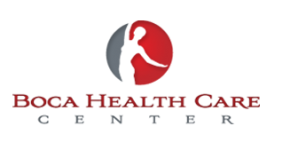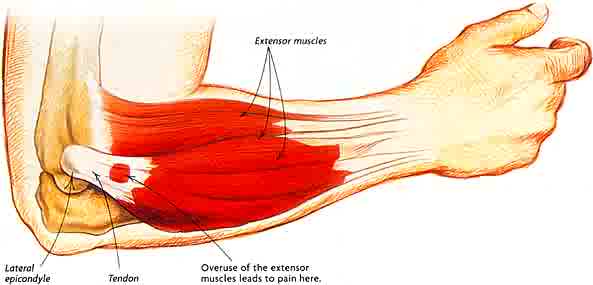Tennis Elbow pain is one of those conditions that seems to hang around forever. If you’re reading this, then you or a loved one suffers with tennis elbow pain, and knows just how annoying, painful, nagging, and a nuisance it really can be.
So let’s discuss what tennis elbow is, how one gets tennis elbow, what traditional medical treatment is for tennis elbow, and them most importantly, what our approach is for tennis elbow at Boca Health Care Center.
Tennis Elbow Revealed:
I think it important to understand the mechanics of the elbow joint in order to understand exactly what tennis elbow is, that way, we can put the best approach together to fix the actual problem(s), or the breakdowns that have occurred.
If you stand straight, with your arms to the side, palms facing forward, on the thumb side, where you bend at the elbow, where the biggest/widest part of the elbow is located, this is known as the lateral epicondyle. On the pinky side, same description (widest part of the elbow), this is known as the medial epicondyle.
Next, because the elbow joint is a hinge type of joint, it is restricted in the types of movements that it is capable of. Like a door on a hinge, the elbow joint opens and closes in similar fashion. The bending of the elbow is also flexing of the elbow, and straightening a bent elbow, is also known as extention. The other movements that that elbow is capable of is turning the palm up and down, also known as supination and pronation. But with tennis elbow, it’s actually the extending or straightening the forearm at the elbow that we are concerned about.
When extended repeatedly over and over, the lateral epicondyle becomes inflamed, that is, the tendons, ligaments, and joint capsule begins to breakdown. The proper name is therefore is Lateral epicondylitis or lateral epicondylalgia, but because the motion of tennis requires straightening a bent elbow for a backswing/wind-up before a shot, it becomes knowns as tennis elbow. Pain, soreness, stabbing, throbbing, and burning lateral elbow pain is the hallmark signs of tennis elbow.
However, one doesn’t just have to be a tennis player to develop tennis elbow. Repeated bending and straightening of the arm with other activities (swimming, cleaning, working with your hands, and even being in front of a computer for upward to 6-8 hours/day) can all predispose you do tennis elbow.
Next lets talk about what you can do about your tennis elbow.
Traditional Medical Approach to Tennis Elbow Vs. My Approach to Tennis Elbow:
I see too many frustrated tennis elbow pain sufferers who’ve “been there done that” with the primary care doctors. Meaning, they went to the primary, they ordered an x-ray, maybe an MRI (more likely not), and all the doctor told you when they reviewed the findings is “you have tennis elbow”.
Even worse, anti-inflammatory helped at first, but stop working or being effective after a while. Pain medication, muscle relaxers, anti-spasmodics, anti-anxiety, anti-depressants, and even anti-seizure medications have not only left you tired and frustrated, but your kidneys and liver have probably taken a beating too. Especially if you’ve been taking prescription medications for longer then 6 weeks.
Even more frustrating is the fact that your doctor isn’t even listening anymore to what your telling them. You may have associated wrist pain, maybe you’re holding your tennis racquet incorrectly, swinging the racquet wrong, putting too much force on your shoulder, and now, you are even experiencing headaches and neck pain. How is medication going to help that.
Next, your doctor recommends you go for an orthopedic surgical evaluation, and if you’re not told you need surgery, you’re told to go for physical therapy. Surgery is not only risky and invasive, but there is no guarantee that it will fix the problem, you are afraid it may make the problem worse, it’s darn right expensive, AND, it doesn’t address the other things that I just mentioned.
So what do I in my office for tennis elbow?
The first thing that sets our office apart and make us unique, is the fact that we do a very thorough neurological work-up to determine whether or not you just have a tennis elbow problem by itself, or if you have a tennis problem along with other “neurological-structural” considerations. Let me explain.
You see, 20% of the people that come in for tennis elbow just have a tennis elbow problem, while 80% have tennis elbow and something else.
In the case of elbow pain, perhaps your biomechanics have broken down, and you ARE holding the racquet wrong, performing faulty ground strokes, putting too much force through your shoulder, your mid back posture/your head carriage/scapular thoracic rhythm have ALL broken down. Maybe you don’t even play tennis and your work station or other activities are contributing. Maybe maybe maybe. All must be addressed. But because your brain function and it’s ability to control everything correctly that we mentioned, we must do a neurological examination first. So what does that entail?
1) Vibration—checking large diameter afferents that fire 270 mph to the brain. They are essential for relating sensory information to your brain. More importantly, they are essential for inhibiting pain.
Other tests involved in our neurological work-up are:
#2: Joint Position Sense
#3: 2-Point Discrimination
#4: Reflexes
#5:Eye Movement
#6: CN 5,7,9,11, 12
#7: Rhombergs #
8: Finger To Nose
#9: Dysdiadochokinesia
#10: Step test
Next, a thorough tennis elbow kinematic chain clearance test will be performed. This evaluates how well your scapula glides on your ribcage, your shoulder movements, neck movements, clavicle movement, elbow movement, and wrist assessment.
Tennis Elbow Support Protocols:
In our office we use a Class IV Cold Laser called the Avicenna Laser. It’s simply awesome. Here’s what it does:
- Accelerated cell reproduction and growth
- Faster wound healing. The laser stimulates fibroblast development (these are like the building blocks) in damaged tissue. This can help in the reduction of recovery time.
- Increased metabolic activity. Helps the body increase output of specific enzymes; induces oxygen to blood cells and more effective immune response.
- Reduced fibrous tissue formation. The laser reduces the formation of scar tissue following tissue damage from cuts, scratches, burns, or following surgery.
- Anti-inflammatory action. The laser reduces swelling caused by bruising or inflammation of joints to give improved joint mobility.
Increased vascular and nerve activity. The laser stimulates lymph and blood circulation to allow the affected tissue to have the best possible circulation. It may help stimulate nerve function. If you have slow recovery or nerve dysfunction in damaged tissue, it can result in “dead” limbs or numb areas. Laser will speed the process of nerve cell reconnection to bring the numb areas back to life. Laser also increases the amplitude of action potentials: to optimize muscle action.
Other treatments we do are:
- Earth Wraps Infa-therapy for deep penetrating heating and healing of the elbow
- Peripheral Neuropathy Rehab Therapy at 7.83 HZ (if we found a problem during our neurological work-up
- C-Spine Spinal Decompression using the DRX 9000 especially if our kinematic chain clearance test found neck problems
- Nutritional Supplementation, especially to reduce pain/inflammation and improve immune function,
So, when you come into our office for our tennis elbow pain treatment protocol, I’m going to give you a thorough neurological as described above, and I am going to give you my best recommendation to help you as fast as possible!
In parting…Information without action is NOT going to help you! Reading this has provided you with the information regarding tennis elbow treatment, now it’s your turn to take action. I look forward to helping you in the future!


